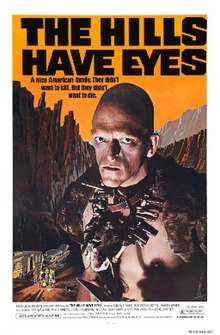
Back التلال لها عيون (فيلم 1977) Arabic التلال لها عيون ARZ Təpələrin gözləri var (film, 1977) Azerbaijani Els turons tenen ulls (pel·lícula de 1977) Catalan The Hills Have Eyes Czech Slagterbanden Danish Hügel der blutigen Augen (1977) German The Hills Have Eyes (película de 1977) Spanish The Hills Have Eyes (1977ko filma) Basque تپهها چشم دارند (فیلم ۱۹۷۷) Persian
| The Hills Have Eyes | |
|---|---|
 Theatrical release poster | |
| Directed by | Wes Craven |
| Written by | Wes Craven |
| Produced by | Peter Locke |
| Starring |
|
| Cinematography | Eric Saarinen[1] |
| Edited by | Wes Craven[1] |
| Music by | Don Peake |
Production company | Blood Relations Company[1] |
| Distributed by | Vanguard[2] |
Release date |
|
Running time | 89 minutes[1] |
| Country | |
| Language | English |
| Budget | $350,000–700,000[1] |
| Box office | $25 million[3] |
The Hills Have Eyes is a 1977 American horror film written, directed, and edited by Wes Craven and starring Susan Lanier, Michael Berryman and Dee Wallace. The film follows the Carters, a suburban family targeted by a family of cannibal savages after becoming stranded in the Nevada desert.
Following Craven's directorial debut, The Last House on the Left (1972), producer Peter Locke was interested in financing a similar project. Craven based the film's script on the legend of Scottish cannibal Sawney Bean, which Craven viewed as illustrating how supposedly civilized people could become savage. Other influences on the film include John Ford's The Grapes of Wrath (1940) and Tobe Hooper's The Texas Chain Saw Massacre (1974). The Hills Have Eyes was shot in the Mojave Desert. The film's crew were initially unenthusiastic about the project, but they became more passionate due to Craven's enthusiasm and came to believe that they were making a special movie.
The Hills Have Eyes earned $25 million at the box office and spawned a franchise. All subsequent films in the series were made with Craven's involvement. The Hills Have Eyes was released on VHS in 1988 and has subsequently been released on DVD and Blu-ray, while Don Peake's score for the film has been released on CD and vinyl. Reviews for the film were mostly positive, with critics praising its tense narrative and humor. Some critics have interpreted the film as containing commentary on morality and American politics, and the film has since become a cult classic.